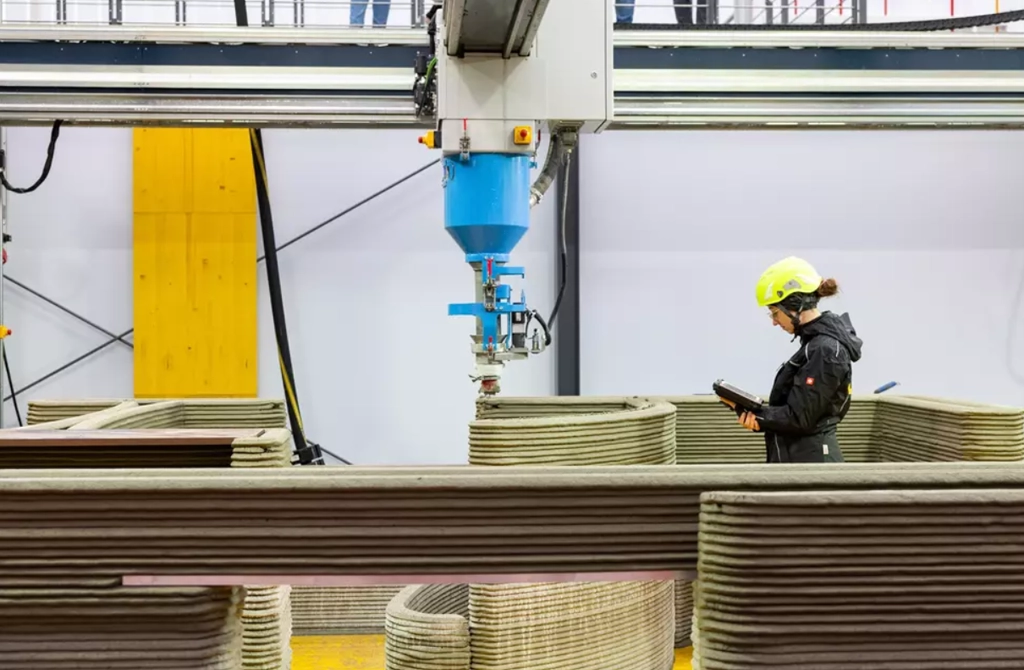The construction industry uses significant amounts of resources and is one of the largest producers of greenhouse gases. For this reason alone, social development aimed at sustainability is unthinkable without essential contributions from the construction industry. bauma 2025 offers an overview of the diverse approaches the construction machinery world has for sustainable construction. The world’s leading trade fair for construction machinery, building material systems, mining machines, construction vehicles and construction equipment will take place from April 7 to 13 at the Munich exhibition center.
Serial construction saves resources
When it comes to conserving resources, serial construction is one of the most promising levers. “Raw materials and materials are used more efficiently than with conventional construction methods, as prefabrication can take place in a controlled industrial environment,” explains Stephan Oehme, consultant for mining, building material plants and construction machinery at the German Mechanical and Plant Engineering Association (VDMA). According to him, this reduces material waste in several ways: production residues and scrap materials that arise in the factory can be recycled more easily – and the buildings are also easier to dismantle at the end of their use and their materials are easier to reuse.
3D printing with secondary raw materials and bio-based materials
Another opportunity to protect natural resources is to use more recycled materials in the 3D printing of buildings. The industry is also researching bio-based materials for additive manufacturing. In any case, there seems to be demand: according to a study by the market research company Exactitude Consultancy, the global market for 3D printing mortar is expected to grow from around 3.5 billion US dollars in 2024 to around 13.8 billion US dollars in 2034.
High recycling rate for mineral construction waste
According to the Circular Economy Construction Initiative, over 90 percent of the approximately 208 million tons of mineral construction waste generated in Germany in 2022 was recycled. “The idea of recycling is now deeply ingrained in the DNA of the construction industry, which is reflected not least in many highly sensible solutions,” comments Oehme. For example, the Wirtgen Group’s cold recyclers can be used to recycle asphalt pavements on site. The existing pavement is granulated with a milling and mixing rotor and processed by adding binding agents, cement and water. The result is a homogeneous building material that is immediately reinstalled.
Electric drives in a wide range of applications
Sustainable construction also includes the goal of decarbonization as far as possible. Alternative drives for mobile construction machines, to which bauma will again be devoting a separate theme in 2025, contribute to this. In addition, electric solutions also prevent exhaust gases and noise from building equipment such as vibrating plates or rammers. The range of products on offer is now so broad that, according to the manufacturer Wacker Neuson, a completely emission-free construction site is already possible today.
Low-emission asphalt mixing
Building material manufacturers are other market players supporting climate-friendly construction. For example, an asphalt mixing plant in Nentershausen, Hesse, is now successfully using the Revoc system from the manufacturer Benninghoven, which was presented as a world premiere at bauma 2022. The retrofitted “catalyst” makes it possible to reduce total carbon emissions by up to 50 percent, while the recycled content in asphalt can be increased to up to 60 percent. Benninghoven also recently launched the world’s first asphalt burner that can be operated 100 percent with green hydrogen.
Sustainable also means socially responsible
“Sustainable construction is by no means limited to resource awareness, recycling of the materials used and a reduced carbon footprint,” emphasises the VDMA expert, and continues: “In addition to economic viability, safeguarding human health is also an essential goal.” For example, reducing construction site noise protects the health of both workers and residents. Many municipalities around the world – such as Munich, London, Paris and Zurich – are encouraging the use of quieter construction machinery through guidelines, regulations and subsidies. Electric machines are not only particularly quiet, but also do not emit any harmful exhaust gases or fine dust in their area of use.


